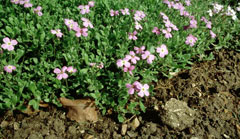 |
|
(c) 2010 Ken Fern & Plants For A Future |
 |
| (c) 2010 Ken Fern & Plants For A Future |
Translate this page:
Summary
Bloom Color: Pink, Purple, Red, White. Main Bloom Time: Early spring, Mid spring. Form: Spreading or horizontal.
Physical Characteristics

 Aubrieta deltoidea is an evergreen Perennial growing to 0.2 m (0ft 8in) by 0.3 m (1ft) at a medium rate.
Aubrieta deltoidea is an evergreen Perennial growing to 0.2 m (0ft 8in) by 0.3 m (1ft) at a medium rate.
See above for USDA hardiness. It is hardy to UK zone 7 and is not frost tender. It is in leaf all year, in flower from April to May, and the seeds ripen in June. The species is hermaphrodite (has both male and female organs) and is pollinated by Bees.
It is noted for attracting wildlife.
Suitable for: light (sandy) and medium (loamy) soils and prefers well-drained soil. Suitable pH: mildly acid, neutral and basic (mildly alkaline) soils. It can grow in semi-shade (light woodland) or no shade. It prefers dry or moist soil and can tolerate drought.
UK Hardiness Map
US Hardiness Map
Synonyms
Plant Habitats
Edible Uses
References More on Edible Uses
Medicinal Uses
Plants For A Future can not take any responsibility for any adverse effects from the use of plants. Always seek advice from a professional before using a plant medicinally.
None known
References More on Medicinal Uses
The Bookshop: Edible Plant Books
Our Latest books on Perennial Plants For Food Forests and Permaculture Gardens in paperback or digital formats.

Edible Tropical Plants
Food Forest Plants for Hotter Conditions: 250+ Plants For Tropical Food Forests & Permaculture Gardens.
More

Edible Temperate Plants
Plants for Your Food Forest: 500 Plants for Temperate Food Forests & Permaculture Gardens.
More

More Books
PFAF have eight books available in paperback and digital formats. Browse the shop for more information.
Shop Now
Other Uses
A useful ground cover for a sunny position, it should be cut back after flowering to prevent it becoming straggly[197]. It forms a carpet of growth[208].
Special Uses
References More on Other Uses
Cultivation details
Landscape Uses:Alpine garden, Container, Ground cover, Rock garden. Prefers full sun and a neutral to alkaline soil[200]. Prefers a limey soil[108]. Dislikes shade except in areas with hot summers[200]. Thrives in any deep rich loam in any situation except in the shade of trees[1]. Plants are apt to die out in heavy or damp soils[111, 200]. Plants can be grown in old walls[219]. A very ornamental plant[1], it is the parent of the cultivated garden aubretias and there are also many named varieties[208]. Plants often self-sow in gardens[219]. A good bee and butterfly plant[30, 108]. Special Features:Attractive foliage, Attracts butterflies.
References Carbon Farming Information and Carbon Sequestration Information
Temperature Converter
Type a value in the Celsius field to convert the value to Fahrenheit:
Fahrenheit:
The PFAF Bookshop
Plants For A Future have a number of books available in paperback and digital form. Book titles include Edible Plants, Edible Perennials, Edible Trees,Edible Shrubs, Woodland Gardening, and Temperate Food Forest Plants. Our new book is Food Forest Plants For Hotter Conditions (Tropical and Sub-Tropical).
Shop Now
Plant Propagation
Seed - surface sow in an outdoor seed bed in the spring. Light aids germination. The seed usually germinates in 2 - 3 weeks at 18°c[134]. When they are growing away well, plant them out into their permanent positions. Division after flowering[111]. Larger divisions can be planted straight into their permanent positions whilst smaller clumps are best potted up and kept in a cold frame until they are growing away well. Cuttings, June/July in a frame[111]. Layering after flowering[1].
Other Names
If available other names are mentioned here
Native Range
TEMPERATE ASIA: Armenia EUROPE: Albania, Bulgaria (southwest), Greece (incl. Crete), Italy (Sicilia), North Macedonia, Romania, Serbia
Weed Potential
Right plant wrong place. We are currently updating this section.
Please note that a plant may be invasive in one area but may not in your area so it's worth checking.
Conservation Status
IUCN Red List of Threatened Plants Status :

Growth: S = slow M = medium F = fast. Soil: L = light (sandy) M = medium H = heavy (clay). pH: A = acid N = neutral B = basic (alkaline). Shade: F = full shade S = semi-shade N = no shade. Moisture: D = dry M = Moist We = wet Wa = water.
Now available:
Food Forest Plants for Mediterranean Conditions
350+ Perennial Plants For Mediterranean and Drier Food Forests and Permaculture Gardens.
[Paperback and eBook]
This is the third in Plants For A Future's series of plant guides for food forests tailored to
specific climate zones. Following volumes on temperate and tropical ecosystems, this book focuses
on species suited to Mediterranean conditions—regions with hot, dry summers and cool, wet winters,
often facing the added challenge of climate change.
Read More
Expert comment
Author
(L.)DC.
Botanical References
45200
Links / References
For a list of references used on this page please go here
Readers comment
| Add a comment |
|
If you have important information about this plant that may help other users please add a comment or link below. Only comments or links that are felt to be directly relevant to a plant will be included. If you think a comment/link or information contained on this page is inaccurate or misleading we would welcome your feedback at [email protected]. If you have questions about a plant please use the Forum on this website as we do not have the resources to answer questions ourselves.
* Please note: the comments by website users are not necessarily those held by PFAF and may give misleading or inaccurate information.
To leave a comment please Register or login here All comments need to be approved so will not appear immediately.
|
Subject : Aubrieta deltoidea
|
|
|
|